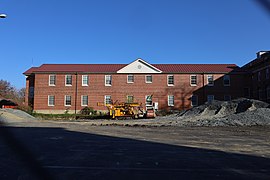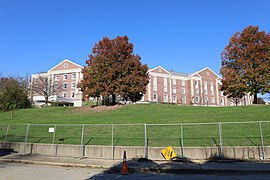
Walter Reed Army Medical Center
The Walter Reed Army Medical Center (WRAMC), officially known as Walter Reed General Hospital (WRGH) until 1951, was the U.S. Army's flagship medical center from 1909 to 2011. Located on 113 acres (46 ha) in Washington, D.C., it served more than 150,000 active and retired personnel from all branches of the United States Armed Forces. The center was named after Walter Reed, a U.S. Army physician and sergeant who led the team that confirmed that yellow fever is transmitted by mosquitoes rather than direct physical contact.
For the hospital in Bethesda, Maryland, see Walter Reed National Military Medical Center. For other uses, see Walter Reed (disambiguation).Walter Reed Army Medical Center
1 May 1909
27 August 2011
![]() United States
United States
Militarized healthcare
"We Provide Warrior Care"
LTG Kevin C. Kiley (2002 – June 2004; 1–2 March 2007)
MG Kenneth L. Farmer Jr. (June 2004 – 25 Aug. 2006)
MG. George W. Weightman (25 Aug. 2006 – 1 March 2007)
MG Carla Hawley-Bowland (final commander)
6900 Georgia Avenue NW, Washington, D.C., United States
Military
1 May 1909
9 March 2015
Since its origins, medical care at the facility grew from a bed capacity of 80 patients to approximately 5,500 rooms covering more than 28 acres (11 ha) of floor space. WRAMC combined with the National Naval Medical Center at Bethesda, Maryland in 2011 to form the tri-service Walter Reed National Military Medical Center (WRNMMC). The grounds and historic buildings of the old campus are being redeveloped as the Parks at Walter Reed.[1]
History[edit]
Origins at Fort McNair[edit]
Fort Lesley J. McNair, located in the southwest of the District of Columbia on land set aside by George Washington as a military reservation, is the third oldest U.S. Army installation in continuous use in the United States after West Point and Carlisle Barracks. Its position at the confluence of the Anacostia River and the Potomac River made it an excellent site for the defense of the nation's capital. Dating back to 1791, the post served as an arsenal, played an important role in the nation's defense, and housed the first U.S. Federal Penitentiary from 1839 to 1862.
Today, Fort McNair enjoys a strong tradition as the intellectual headquarters for defense. Furthermore, with unparalleled vistas of the picturesque waterfront and the opposing Virginia shoreline, the historic health clinic at Fort McNair, the precursor of today's Walter Reed Army Medical Center (WRAMC), overlooks the residences of top officials who choose the famed facility for the delivery of their health care needs.
"Walter Reed's Clinic," the location of the present day health clinic at Washington, D.C., occupies what was from 1898 until 1909 the General Hospital at what was then Washington Barracks, long before the post was renamed in honor of Lt. Gen. McNair who was killed in 1944. The hospital served as the forerunner of Walter Reed General Hospital; however, the Victorian era waterfront dispensary remains and is perhaps one of America's most historically significant military medical treatment facilities. It is reported that Walter Reed lived and worked in the facility when he was assigned as Camp Surgeon from 1881 to 1882. After having served on other assignments, he returned as Professor of Medicine and Curator of the Army Medical Museum. Some of his epidemiological work included studies at Washington Barracks, and he is best known for discovering the transmission of yellow fever. In 1902, Major Reed underwent emergency surgery here for appendicitis and died of complications in this U.S. Army Medical Treatment Facility (MTF), within the very walls of what became his final military duty assignment.[2]
Regarding the structure itself, since the 1890s the health clinic was used as an Army General Hospital where physicians, corpsmen and nurses were trained in military health care. In 1899, the morgue was constructed which now houses the Dental Clinic, and in 1901 the hospital became an entirely separate command. This new organizational command relocated eight years later with the aide of horse-drawn wagons and an experimental steam driven ambulance in 1909. Departing from the 50-bed hospital, as documented in The Army Nursing Newsletter, Volume 99, Issue 2, February 2000,[3] they set out due north transporting with them 11 patients initially to the new 65-bed facility in the northern aspect of the capital. Having departed Ft. McNair, the organization has since developed into the Walter Reed Army Medical Center that we know today.
As for the facility they left behind at Fort McNair, it functioned in a smaller role as a post hospital until 1911 when the west wing was converted into a clinic.
Walter Reed General Hospital and WRAMC[edit]
Congressional legislation appropriated $192,000 for the construction of Walter Reed General Hospital[4] (WRGH, now known as "Building 1"). The firm of Marah & Peter did the architectural designs, and Cramp & Company was awarded the construction contract.[4] was the Construction began in 1907.[4] The first ten patients were admitted on 1 May 1909. Lieutenant Colonel William Cline Borden was the initiator, planner and effective mover for the creation, location, and first Congressional support of the Medical Center. Due to his efforts, the facility was nicknamed "Borden's Dream."[5]
In 1923, General John J. Pershing signed the War Department order creating the "Army Medical Center" (AMC) within the same campus as the WRGH. (At this time, the Army Medical School was relocated from 604 Louisiana Avenue and became the "Medical Department Professional Service School" (MDPSS) in the new Building 40.) Pershing lived at Walter Reed from 1944 until his death there 15 July 1948.
In addition to the WRAMC hospital complex, the WRAMC installation hosted a number of other related activities and organizations.
























